Return of the Cicadas is a documentary about the return of the Brood X periodical cicadas, by producer Samuel Orr. It is worth watching for for folks in the Brood II area so they know what to expect.
Take a look:
Cicada researchers associated with academic institutions.
Return of the Cicadas is a documentary about the return of the Brood X periodical cicadas, by producer Samuel Orr. It is worth watching for for folks in the Brood II area so they know what to expect.
Take a look:
Gene Kritsky is one of the leading periodical cicada researchers. He’s asked that we help with his research regarding temperature and cicada emergence. He needs to know the date that cicadas first emerge, and then the date when they appear in large numbers in a given locality. To contact Gene with your findings, email him at cdarwin@aol.com.
Here are the details:
I wanted to alert you to a paper that I published with Roy after Brood XIV. I had placed sensors at cicada depths in Roy’s backyard, and also hung others in the area trees. We recorded the temperatures at 10 minute intervals at all the locations. I was trying to find a weather model to predict soil temperatures without using probes. This would be cheaper for people wanting to monitor an impending emergence. This research is based on what potato farmers do to track the growth of their crop.
We found that the average of the running three day and two day mean temperatures was a good predictor of soil temps.
The formula along with the extended forecast can be used to forecast soil temperatures. Once we get the 64º F soil temps and a nice rain we got emergences. I am hoping to test this model again this year, which in part is why I emailing you. What I need to know is the date that cicadas first emerge, and then the date when they appear in large numbers in a given locality. I will then use weather data to check the soil model. Can you ask readers to send me that info? Many thanks.
You can find more details on the model at:
http://inside.msj.edu/academics/faculty/kritskg/cicada/Site/Estimating_soil_temperature.html
An easier way of getting to the details is to go to www.msj.edu/cicada and click on estimating soil temperatures. That site will also link them to John’s mapping page, activities for kids, etc.
Thank you for your help.
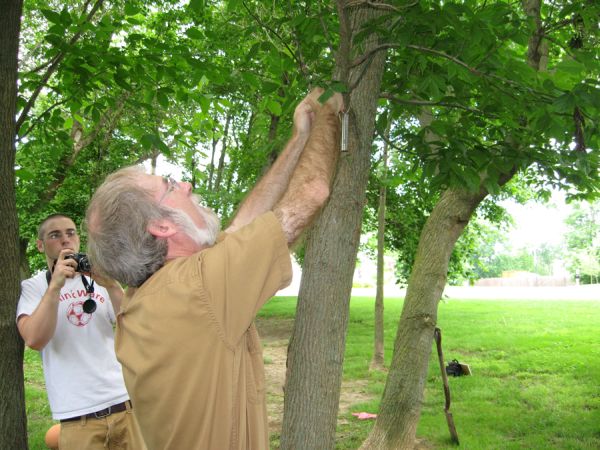
More info about Gene Kritsky:
John Cooley of Cicadas @ UCONN (formerly Magicicada.org) kindly provided us with an updated version of the Brood II map. The old map was circa 1907. Click the image below for a BIG version:
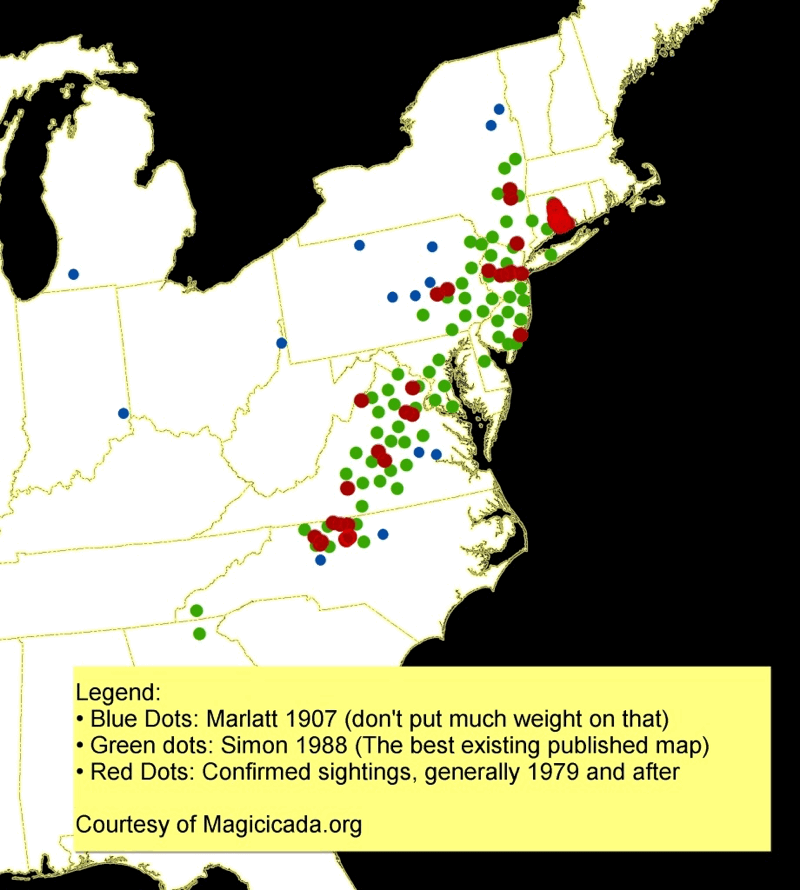
Download the PDF here: www.cicadamania.com/downloads/diversity-05-00166.pdf.
We are excited to announce the availability of a document by Allen F. Sanborn and Polly K. Phillips titled Biogeography of the Cicadas (Hemiptera: Cicadidae) of North America, North of Mexico. This document features distribution maps for North American cicada species! This document is an excellent companion to The Cicadas (Hemiptera: Cicadoidea: Cicadidae) of North America North of Mexico by Allen F. Sanborn and Maxine S. Heath (link to that book).
Abstract: We describe and illustrate the biogeography of the cicadas inhabiting continental North America, north of Mexico. Species distributions were determined through our collecting efforts as well as label data from more than 110 institutional collections. The status of subspecies is discussed with respect to their distributions. As we have shown over limited geographic areas, the distribution of individual species is related to the habitat in which they are found. We discuss the biogeography of the genera with respect to their phylogenetic relationships. California is the state with the greatest alpha diversity (89 species, 46.6% of taxa) and unique species (35 species, 18.3% of taxa). Texas, Arizona, Colorado and Utah are the states with the next greatest alpha diversity with Texas, Arizona and Utah being next for unique species diversity. Maine, New Hampshire and Rhode Island are the states with the least amount of cicada diversity. Diversity is greatest in states and areas where there is a diversity of plant communities and habitats within these communities. Mountainous terrain also coincides with increases in diversity. Several regions of the focus area require additional collection efforts to fill in the distributions of several species.
Keywords: cicada; distribution; Diceroprocta; Tibicen; Okanagana; Okanagodes; Cacama; Magicicada; Platypedia; Cicadetta
An example of a map from the document:

What is crowdsourcing? Here is what the Wikipedia says:
Crowdsourcing is the practice of obtaining needed services, ideas, or content by soliciting contributions from a large group of people, and especially from an online community, rather than from traditional employees or suppliers. Often used to subdivide tedious work or to fund-raise startup companies and charities, this process can occur both online and offline.
There are two prominent cicada crowdsourcing efforts you can take part in!
First, there is the Cicada Tracker project:
The group Radiolab is hoping you’ll build what they call a cicada tracker. A cicada tracker will measure the temperature of the soil and report that back to Radiolab, to help estimate the arrival of the cicadas. Here is a short video about the project:
The Cicadas Are Coming! from Radiolab on Vimeo.
Throughout April there will be events where you can get to together with other cicada enthusiasts, and build cicada trackers. See their website for more details.
Second, there is Cicadas @ UCONN (formerly Magicicada.org).
Cicadas @ UCONN (formerly Magicicada.org) is a website where you can report and map cicada emergences in your area. I strongly suggest that everyone visits that site to report their cicada sightings. Your reports will be used to build new and better maps of the periodical cicada populations in the U.S.A.
When you visit their site, look for this icon, click it and enter your report:
Information needed for the report include the location (GPS coordinates, or simple street address), and what you observed: was it a nymph or adult, how many were there, etc. I think they’ll even have a Google maps interface to help you locate your sighting.
I spent most of the day at the Staten Island Museum. The Staten Island Museum has North America’s largest collection of cicadas — over 35,000 specimens!!! Most, if not all the specimens came from William T. Davis’ personal collection. Davis was a naturalist and entomologist located in Staten Island, NY, who was active in the late 1800’s and early 1900’s. Read more about the collection.
The museum is currently working on a huge cicada exhibit and many cicada events throughout the year. The They’re Baaack! Return of the 17-year Cicada Family Day event will happen in a few weeks.
Here’s a few shots of the museum and the collection I took with my camera phone:
Part of their giant Wall of Insects:
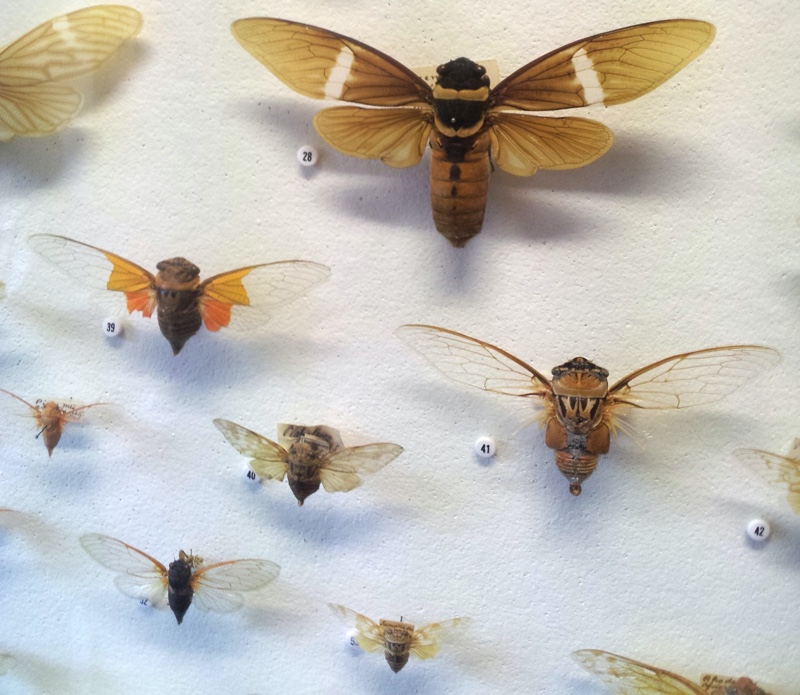
Number 39 in that photo is Hemisciera maculipennis, aka the “stop and go cicada”. When alive the cicada’s coloring is green and red, like a traffic signal. Here is a photo of a live H. maculipennis.
Tibicen and Cicada Killer Wasps:
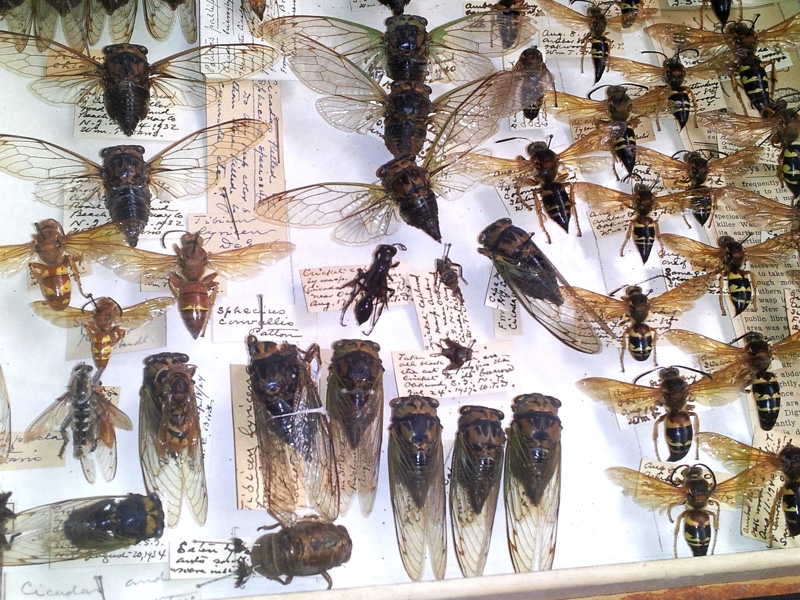
Tacua speciosa detail:
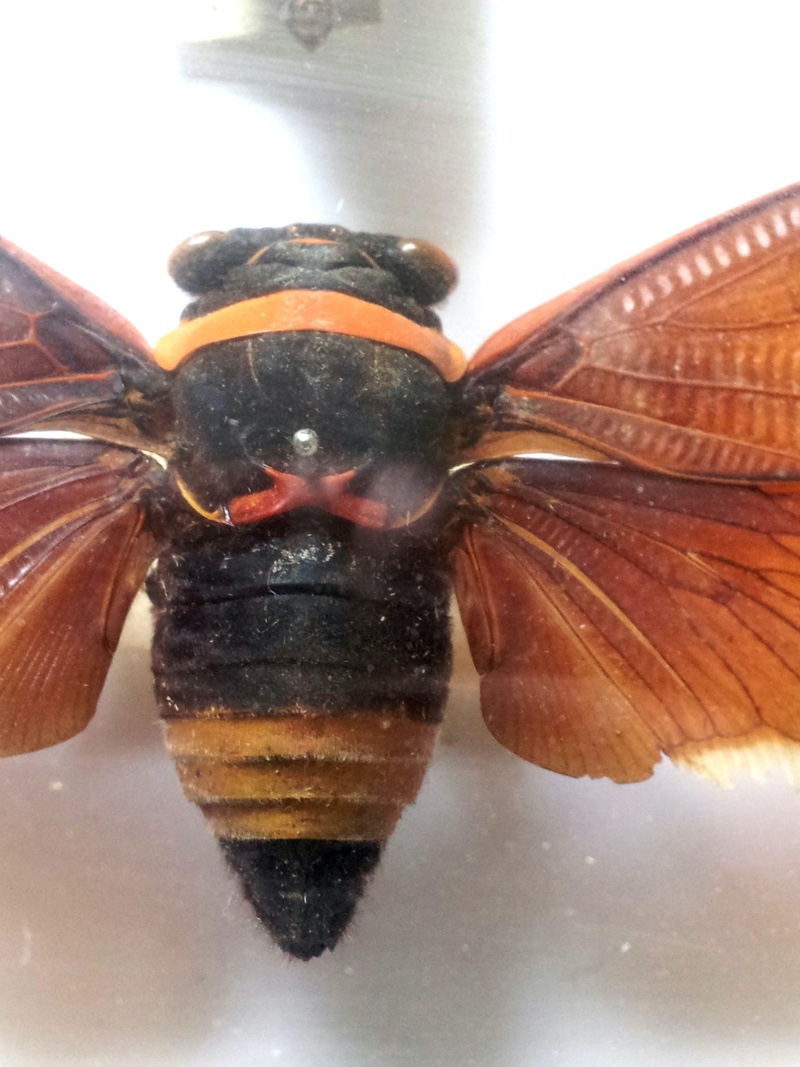
A giant light-up cicada outside the museum:

Just part of the Staten Island Museum’s cicada collection
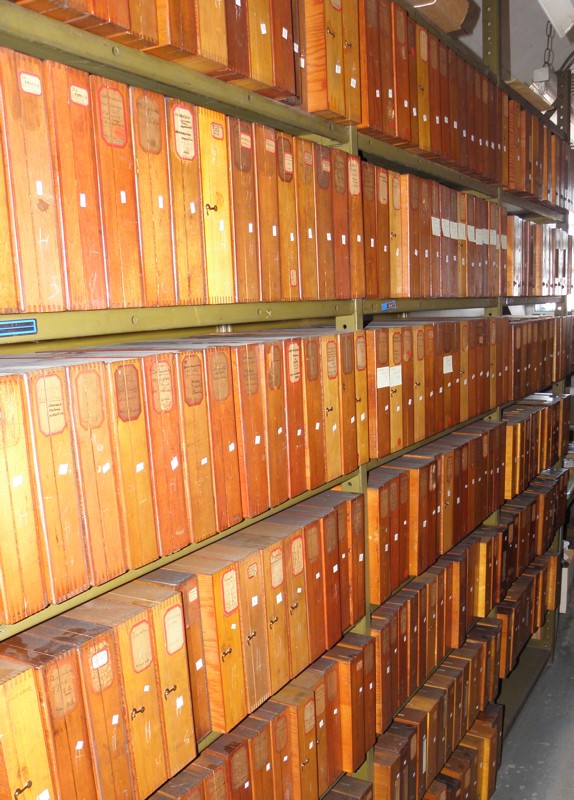
Thanks to Ed Johnson, Director of Science, for showing me many of amazing specimens in the museum’s collection.
Bonus: You can download a copy of William T. Davis’ document North American Cicadas. It’s free!
It looks like there’s a new The Cicadas of Thailand book out (or coming out soon).
ISBN 978-974-480-165-4
WL Order Code 22 645
Bangkok 2011
Boulard, Michel; The Cicadas of Thailand, Vol.2. Taxonomy and Sonic Ethology
White Lotus Press
Looks like it will be for sale here.

Tosena is a genus of cicadas that can be found in the Indo-Malaya ecozone, which includes the Indian subcontinent, Southeastern Asia and southern China. Tosena cicadas have colorful wings, which rival the beauty of butterfly wings. Tosena are easily obtainable online from stores that sell insects, or ebay. The Tosena genus was first identified by Charles Jean-Baptiste Amyot & Jean Guillaume Audinet-Serville in 1843.
From A Monograph of Oriental Cicadidae by W. L. Distant:
Tosena is one of the most conspicuous genera of the Cicadidae, and its species are all included in this fauna. The north-eastern districts of Continental India are its head-quarters, for here are focused some of the largest and handsomest of its species ; it is also well represented in Burma, and from thence its distribution is extended throughout the Malay Peninsula to the south, and apparently northward as far as some portions of China. In the Malayan Archipelago it is not uncommon in Sumatra, Java, and Borneo, and as I have seen representatives from Amboyna, it probably exists in other intervening islands, of which, however, we have at present no precise information.
Different types of Tosena:
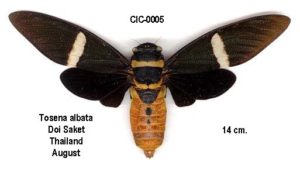
Photo by Michel Chantraine.
Distinguishing features: Mustard colored pronotal collar, orange abdomen with a series of two black circular spots, and dark brown wings with one white stripe on each fore wing.
Habitat: Southeast Asia.
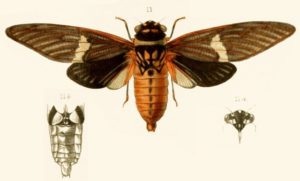
Illustration from A Monograph of Oriental Cicadidae by W. L. Distant.
Distinguishing features: A vibrant green pronotal collar; an orange abdomen with a series of black markings; wings are dark brown to black, with the one white stripe on each fore wing, and a white anal lobe on each hind wing.
Phantastic songs of the S.E. Asian cicadas! website has an MP3 of a T. depicta singing.
Habitat: Southeast Asia.

Tosena fasciata by Ãlvaro Lisón Gómez Creative Commons License.
Distinguishing features: A pale orange pronotal collar; brown wings with one white stripe on each fore wing; an orange abdomen with one black spot; the the anal lobe of the hind wing appears lighter in color than the rest of the hind wing.
Habitat: Southeast Asia.
No photos.
Distinguishing features: See A Monograph of Oriental Cicadidae by W. L. Distant
Habitat: India.
Photos of a live T. melanoptera.
Distinguishing features: Red eyes; white pronotal collar; pale brown stripe on dark brown fore wings.
Habitat: India & Southeast Asia.
No photos.
Distinguishing features: See A Monograph of Oriental Cicadidae by W. L. Distant
Habitat: India.
Two relatively new cicada publications that should be worth reading:
1) Avian Predation Pressure as a Potential Driver of Periodical Cicada Cycle Length by Walter D. Koenig and Andrew M. Liebhold, The American Naturalist. This is a newly electronically published paper about what drives the long, prime-numbered lifecycle of Magicicada periodical cicadas.
Abstract:
The extraordinarily long life cycles, synchronous emergences at 13- or 17-year intervals, and complex geographic distribution of periodical cicadas (Magicicada spp.) in eastern North America are a long-standing evolutionary enigma. Although a variety of factors, including satiation of aboveground predators and avoidance of interbrood hybridization, have been hypothesized to shape the evolution of this system, no empirical support for these mechanisms has previously been reported, beyond the observation that bird predation can extirpate small, experimentally mistimed emergences. Here we show that periodical cicada emergences appear to set populations of potential avian predators on numerical trajectories that result in significantly lower potential predation pressure during the subsequent emergence. This result provides new support for the importance of predators in shaping periodical cicada life history, offers an ecological rationale for why emergences are synchronized at the observed multiyear intervals, and may explain some of the developmental plasticity observed in these unique insects.
2) The Cicadas (Hemiptera: Cicadoidea: Cicadidae) of N. America North of Mexico by Allen F. Sanborn and Maxine S. Heath. 227 pages.
A comprehensive review of the North Amerian cicada fauna that provides information on synonymies, type localities, and type material. There are 170 species and 21 subspecies found in continental N. America north of Mexico. The book has 211 figures with each species photographed in color.
Buy it from the Entomological Society of America website. I’ve already ordered mine.
I can’t wait for Sanborn’s book on Central and South America (hopefully, that will arrive within the next few years).
Update:
I’ve received Allen F. Sanborn and Maxine S. Heath’s book. It’s focus is on identifying all species of cicada fauna in North America, north of Mexico, as the title says. It also identifies species that were reported to exist in this location, but do not. The book provides maps and common attributes of each genus of cicada, and then for each species it provides photos of the holotype (and the location of the holotype), as well as a history of its taxonomy.
An excellent photo of mating Bladder cicadas (Cystosoma saundersii) by David Emery.